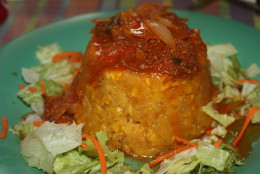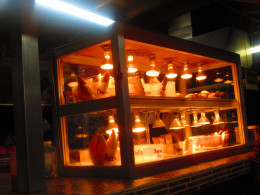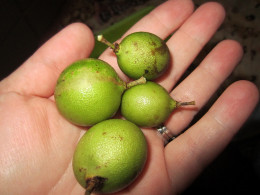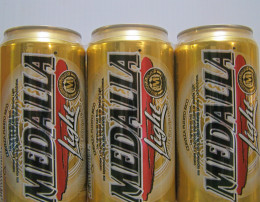Feature
Bill Alvarez


Rice and beans are everywhere, and have long been a staple of the Puerto Rican diet. The rice is usually white, and the beans most often red kidney beans, but different varieties of both are used. The island's diet is also heavy on pork, and is often found inside pasteles (which are a sort of turnover) on kabobs (orpinchos) and in sausages. Pork chops are also popular. Lechon asado (pork roasted over an open fire) is also popular, and the best lechon can be found outside of the San Juan metro area. If you like skirt steak ("churrasco") you're in luck, because it's everywhere.
You will also find some pretty incredible sandwiches in Puerto Rico. Pan de agua, or water bread, is like a french/italian bread, and is always sold in loaves (a sweeter variant is known as pan sobao). It is delicious and can really make a sandwich. The best sandwich you'll have in PR will probably be the tripleta, which -- as per its name -- has three different kinds of meat. A common combination would be steak, ham and roasted pork, with some mayo, potato sticks, lettuce and ketchup, served on pan de agua. After a night of drinking, nothing quite hits the spot like that 4:00 AM Tripleta.
Frituras are fried foods (or snacks, really) that are commonly sold in stalls or kiosks. These stands are almost always near the beach, and are very common on Road 187, as you go into Piñones from San Juan, and on the service road by Luquillo Beach. Alcapurrias are cigar-shaped masses of fried yautia (a locally grown tuber) and plantain, filled with either ground beef or crab. Bacalaitos are shaped like pancakes, and are made from a batter of flour and codfish. Both are delicious, although certainly not health food (frituras are often fried in lard over open fires). Don't be afraid and try some of the local food; even if it looks weird at first, your taste buds will thank you. The stuff from the beachside kiosks is usually tasty and safe to eat.

You'll also see plenty of fruits and vegetables that you have probably never seen before. Quenepas are a round fruit with a tough, green skin, inside of which a large pit is surrounded by a sweet paste. When they are in season, you will see people selling quenepas in bunches by the side of the road. Stop and try some. Don't get them on your clothes, though. You'll also come across mangoes, guava, bananas, oranges, along with several root vegetables (referred to collectively as "verduras" ) which for the most part have names that don't seem to have English translations: yuca, yautia, ñame and malanga, among others. Go the Plaza del Mercado in Santurce (what you would call a "farmer's market" in the rest of the U.S., except this one is not for yuppies) and check out the dizzying variety of local ingredients and foods.

As far as drinks go, Medalla is the main local beer, and is normally found for about a dollar a can. It is a light lager with not much body, but it is easy to drink and gets the job done. Rum is plentiful and relatively cheap; try some of the lesser-known local brands like Barrilito or Ron Llave. Piña Coladas were allegedly invented in Puerto Rico (at the restaurant Barrachina, in Old San Juan, specifically), and you haven't had a piña colada until you've had one in Puerto Rico. Want to try some coconut or pineapple soda? PR would be the place to do so. Malta is also big on the island. It is a carbonated, malted beverage, similar to beer, except that it is dark, sweet and non-alcoholic. If you visit near the holidays, try coquito, which is a coconut-heavy version of eggnog and is usually spiked with rum (ho-ho-HO!). Fruit juices are also a popular drink on the island. And yes, the water is okay to drink.
For more information on visiting Puerto Rico, check out The Real Deal Guide to
Puerto Rico, available as an e-book.
Puerto Rico, available as an e-book.

No comments:
Post a Comment